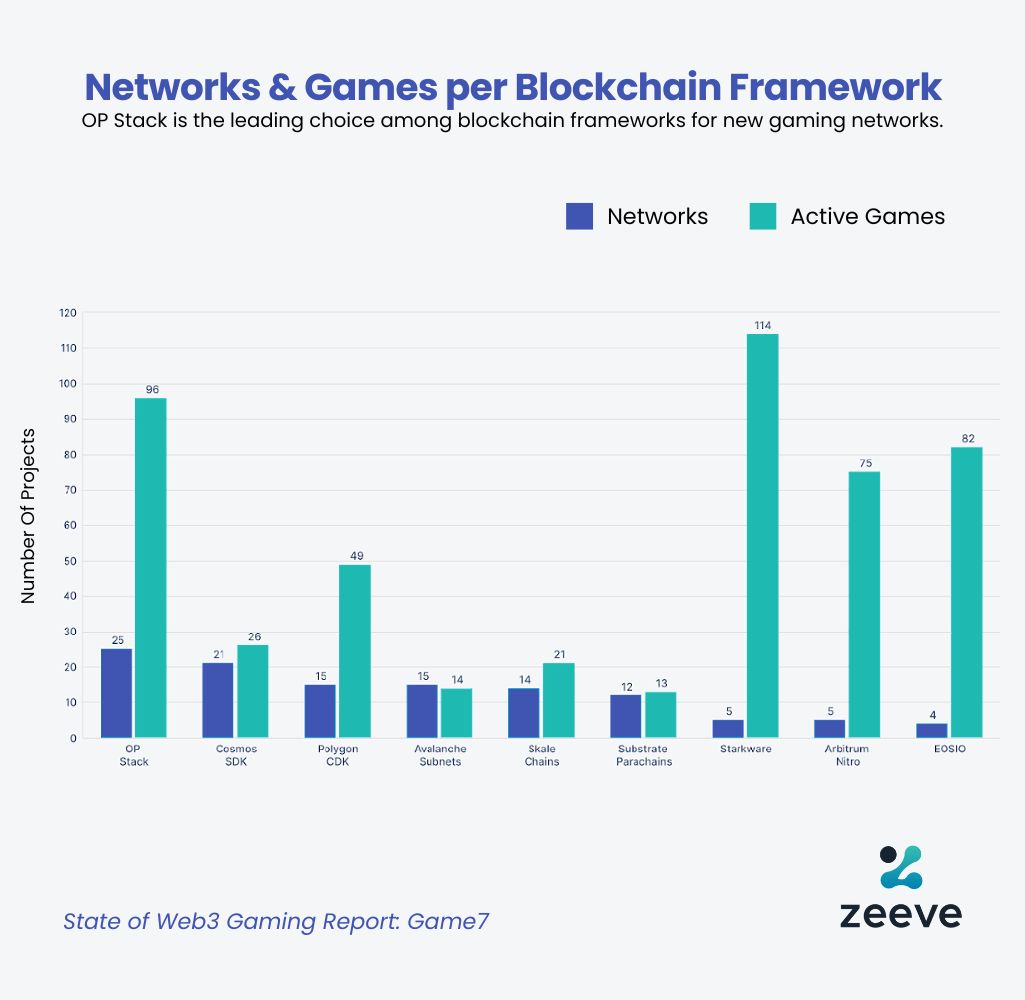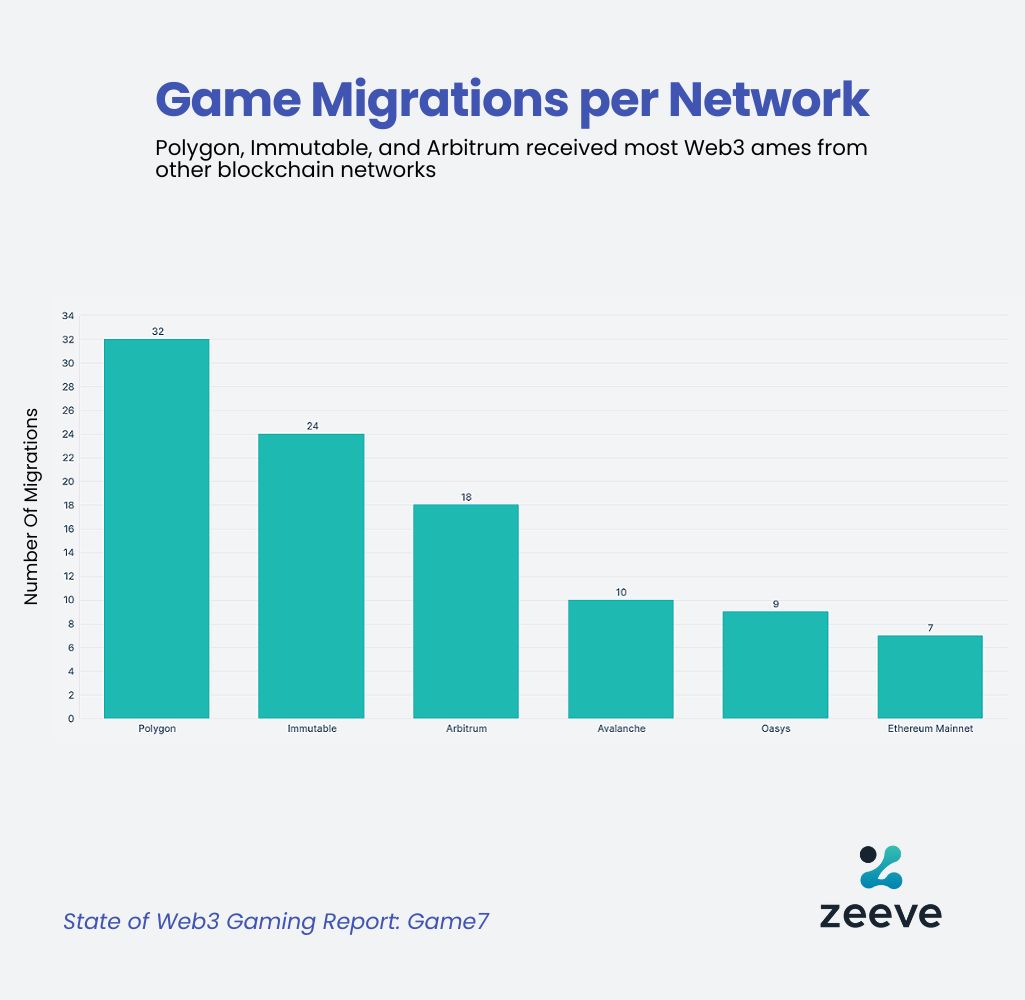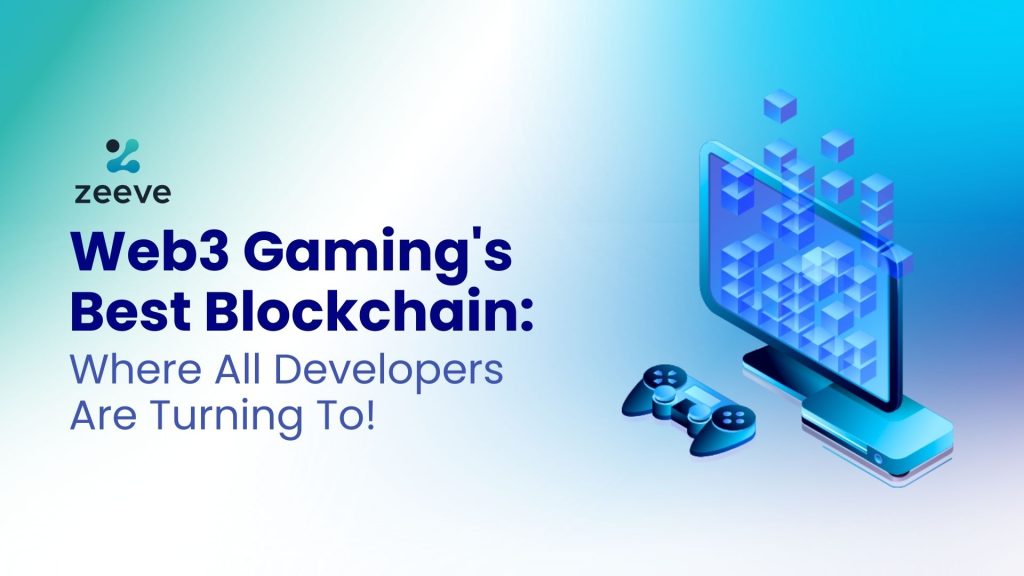After undergoing rigorous improvements at the technology level on L1s, a common narrative flies thick that Web 3 gaming is majorly concentrated on Layer 1 blockchains like Ethereum, Solana and Avalanche. However, after looking at the speed of development of new L3 chains and the leverages they grant, at the time of writing, more than 81 new blockchains have inundated the gaming horizon around L3; filling up specific gaps left by traditional L1s and general-purpose scaling L2s.
In this article, we shall see the top blockchains that saw the majority of the fresh gaming launches and also 3 hot favorite blockchain ecosystems when it comes to migration of any games.
These 3 took away 60% of fresh games launched:
Arbitrum
Arbitrum stack in the short span of time attracted 75 games in 2023 and the momentum has not stopped with the addition of another 14 games in 2024 on its ecosystem due to the following reasons;
- The Gaming Catalyst Program (CGP)
The Gaming Catalyst Program, or CGP, is one of the latest trade-offs of the Arbitrum Orbit chain, which is amplifying game development and improving game mechanics. In the CGP program, the Arbitrum ecosystem is earmarking 200 Million ARB tokens that will help developers build complete custom gaming chains without the challenge of building everything from scratch. So, it is saving considerable time to market without compromising the game mechanism.
XAI has pivoted to Arbitrum due to this trade-off because they wanted to improve wallet management for parallel processing, which demands higher throughput and better gas optimisation than the Arbitrum stack has provided.
Moreover, the CCP program also delves into improving the game model through the introduction of Sticky games, attracting developers of key games like Playnance, SmolBound, Rimverse, Zeeverse, PlayBitmate and KuroroBeast to use the Arbitrum Stack,

- Diversifying Network
Arbitrum is introducing many connected L2 ecosystems like the Arbitrum One ecosystem with a $1.6 B TVL, giving games access to the DeFi ecosystem. At the moment, we have already seen that games want to tap into a multi-chain ecosystem to counter liquidity challenges. Arbitrum Orbit’s Stylus upgrades allow developers to write programs in Rust, C++, and more to allow them to interact with other gaming ecosystems. Pirate Nation, which is a Multi-chain gaming ecosystem, wanted to have simplicity in trading NFTs, staking and experiencing a better in-game environment. Arbitrum AnyTrust chains provided them with an edge to indulge in cross-chain NFT transfer in the most cost-effective manner.
XAI, a gaming blockchain, is also launching on the Arbitrum chain because of this trade-off since they want to bring the combination of Web 2.5 and Web 3 games launching on Arbitrum Nova, allowing game developers to have cheaper access to the blockspace using DAC and faster finality/withdrawal for NFTs when compared to other general-purpose L2 scaling solutions. Other games like Rhascau and Battle For Blockchain have the purpose of reducing fees which have attracted them to develop on top of the Arbitrum Stack.
Optimism
Even OP Stack is not far behind, on the contrary, it is leading the charge by hosting more than 96 games on top of it when compared to Arbitrum and the reasons which are listed below are to blame for that;
- One Ecosystem for All
Gaming has been the sector moving the needle of blockchains; despite that fact, the challenge lies in uniting all the games and different ecosystems launched on top of it. Why? Because, earlier we had just 3 to 4 blockchains in 2018, now we have more than 80+ blockchains live and running. If you are developing on a single ecosystem, it is like building on an Island with no means to connect. That’s where Op Stack is making a difference.
Due to its superchain thesis, Op Stack has combined all the gaming ecosystem as one restoring interconnectedness and operability with the larger ecosystem like Base, Zora Network, Worldcoin, opBNB, and Ancient8. Hence, if you are building a new game and you get access to a wider network, there’s a greater chance of success since Op Stack allows low-cost block space amalgamation and the ability to launch applications on your own terms and connect with other ecosystems minus messaging layers or bridges, which have a past record of vulnerabilities in the form of bridge attacks.
These trade-offs have been utilized by games like Sky Strife, Promodium, Cellula and Kamigotchi, which use the MUD framework of Op Stack, allowing them to optimize the development process from scratch by integrating store contacts that facilitate superior data management through a world contract connecting blockchain seamless, which not only holds data logic of the Dapps but also relays them across for better operability with an alien ecosystem. Due to this, it becomes seemingly easier to connect with different gaming Dapps hosted in different gaming ecosystems of Optimism, unifying a one-chain ecosystem for all the games and eliminating any instances of liquidity fragmentation in their gaming ecosystem.
- Most Stable & Battle Tested Track Record
Optimism has been introducing a series of upgrades improving their network to launch games in a flash. Their latest improvement was the Bedrock upgrade, which has significantly reduced the coding overheads that game developers have to go through while developing the games. As a result of this upgrade, the erstwhile challenges where developers had to deploy codes for new feature integration have been done away with.
The outcome is lower fees, reduced deposit time, enhanced modularity, optimized node performance, and very closely connected Ethereum equivalence which developers have lauded on Crypto Twitter. So, if Op stack is emerging as the game changer for game development, as evidenced by the Game7 Research Outlook hosting as many as 96 games at the time of writing, it shouldn’t come as a surprise because the tech stack is matured and ready for innovation.
- Superchain Developer Console
Like its counterpart Arbitrum Orbit, which has launched the CGP or Gaming Catalyst Program, Optimism is launching a Superchain Developer Console to beat the noise of simplifying game development in the L2 realm. In this Superchain Developer Console, game developers will have access to testnet faucets, custom apps and UX feedback, significantly improving the time-to-market lag of new gaming dapps.
Furthermore, developers will be getting access to test-eth-tokens, allowing them greater opportunities to build their gaming dapps on top of the Op Stack. The Op Stack ecosystem under its Superchain Developer Console upgrade will contribute to gas sponsoring on the gaming environment and will also be triggering a suite of other features further to improve the game development experience of the developers.
- Low Latency
OP Stack allows low latency and higher scalability on its ecosystem, which is another reason that is driving developers to choose the OP Stack for game development because when playing fast-paced play-to-earn games, the players are looking for better in-game experience without stickiness in the game in the form of UI freezing or high fees. Through the use of OP Stack, such an advantage has been created, attracting games like Cocos-BCX to use OP Stack as their go-to choice because they want to use the MUD Stack that will help them in amplifying the game development.
Starkware
If you have been thinking that Arbitrum and Optimism have something unparalleled to offer bringing developers towards their stack, maybe we should reconsider this narrative because Starkware is reigning supreme with more than 114 games launched due to the following reasons;
- Scalability in Gaming
Starkware is introducing Madara, which is a special kind of sequencer that can be customized to build efficient AppChains. Right now, game developers have to struggle when looking for a faster transaction system. They have to either choose between scalability or security. Starkware is designed in a manner to cater to this dilemma, allowing more games to develop on top of it. Cairo’s capabilities are uncontested and it is providing near finality and scalability to the gaming dapps.
- Launch of the Gaming Committee
Starkware is launching a gaming committee comprising six members with the likes of Henri Lieutaud, Starknet’s developer relations head; Chris Lexmond, the founder of Unstoppable Games; and Gabin Marignier, a co-founder of Web3-based productivity app Focus Tree, Oli Feuler, Starknet ecosystem developer from Starknet development firm StarkWare; Tarrence van As, co-founder of Starknet-based “gaming console” Cartridge; and the pseudonymous creator of Starknet-based game Realms World known as “LordOfAFew” or “LOAF.”
These are the folks who are planning to provide the required assistance to game developers to help launch their games within an autonomous world where the games can enjoy constant accessibility, multiplayer interactivity, immunity to shutdown and unrestricted user engagement.
Due to these trade-offs, the Starkware ecosystem is ending up as the first-of-its-kind high TPS games on-chain. DOJO Engine, Katana, Sozo, and Tori are using the Starkware ecosystem because they wanted features where the user’s action should not be made public before the game changes. In such a situation, the need was to keep the user information off-chain and could easily be called upon the need of the client. Hence, Starkware is allowing the concept of proof of publication where even multiplayer games can store the user’s data on-chain for validation. In this way, allowing gamers to participate in the ecosystem and democratize the gaming ecosystem.
What About Game Migration? Who is taking the Bigger Pie?

When you look at the chart above, we can clearly see that Polygon has an edge over its peers like ImmutableX and Arbitrum. Let’s see why games are moving to these chains one by one.
Polygon
Polygon has been leading from the front when it comes to favorite blockchain to either launch afresh or move to it as evident from the chart.
So far more than 20 games have been freshly launched and additionally 14 others have migrated to the Polygon chain. When a closer look was taken, it has been unveiled that games are migrating more towards Polygon because Polygon is abstracting development from game play. For example, game developers have to focus more on improving the game-play rather than cracking the complex technicalities of the blockchain like integrating NFTs and streamlining sustainable technology models to bind users/gamers.
Polygon solving specific problems like transaction fees, throughput, developer support and user base, has attracted projects like Trikon to develop games on top of it. Trikon’s first preference was solving the low entry barriers, resolving the bot problems, ensuring customizable game environments and helping them tap into a wider audience. In all these aspects, the Polygon chain has been exemplary not only for Trikon but also other games like Knight and Peasants, who wanted to migrate to a chain that is less expensive and exhibits a better chance of growth. Polygon has promised that to the gaming community, attracting many games towards it.
Arbitrum
Arbitrum is another noteworthy chain to look forward to attracting more than 15+ games towards it. At the time of writing, games like Aurory, WSG or Wall Street Games, Game of Silk, Pirate Nation, Plannace and others have moved to Arbitrum for a variety of reasons that we have captured in our previous blog that you refer to for more updates. In the coming days, we might see more activities returning or Arbitrum post its CGP launch that will dramatically improve the Web 3 gaming.
Immutable X
The flood of Web 3 gaming has grown strong requiring superior infrastructure that not only aids in improving the scalability but also makes migration seamless. Since immutable X mirrors an EVM equivalence environment with the trade-off of superior scalability, games are turning towards ImmutableX for upgrades. Using the ZkEVM API of ImmutableX and SDK, it becomes very easy to migrate to a new environment like Tiny Colony, which is not only looking for faster speed but also wants high level security to make Web 3 gaming less risky. In this regard, the Immutable X ecosystem has provided all the advantages to games like Tiny Colony and others can experience when moving to a new chain.
Launch Your Game-tailored Chain With Zeeve RaaS
Zeeve is a growing gaming rollup infrastructure provider to launch your Web 3 games with a simple click of a button. Users can launch on DevNet to try different configurations, if things are good, they can move to testnet and then finally the full-fledged mainnet. They can choose on/off-chain data availability, centralized/decentralized sequencers, and other crucial integrations, with 24/7 monitoring, analytics, and alerts, Zeeve has everything that you need to launch your Web 3 game on your preferred tech stack like Optimism’s OP Stack, Arbitrum Orbit, Polygon CDK or zkSync ZK Stack.
For more details, visit our webpage or schedule a call with our service team to help you in launching your Web 3 game smoothly.























